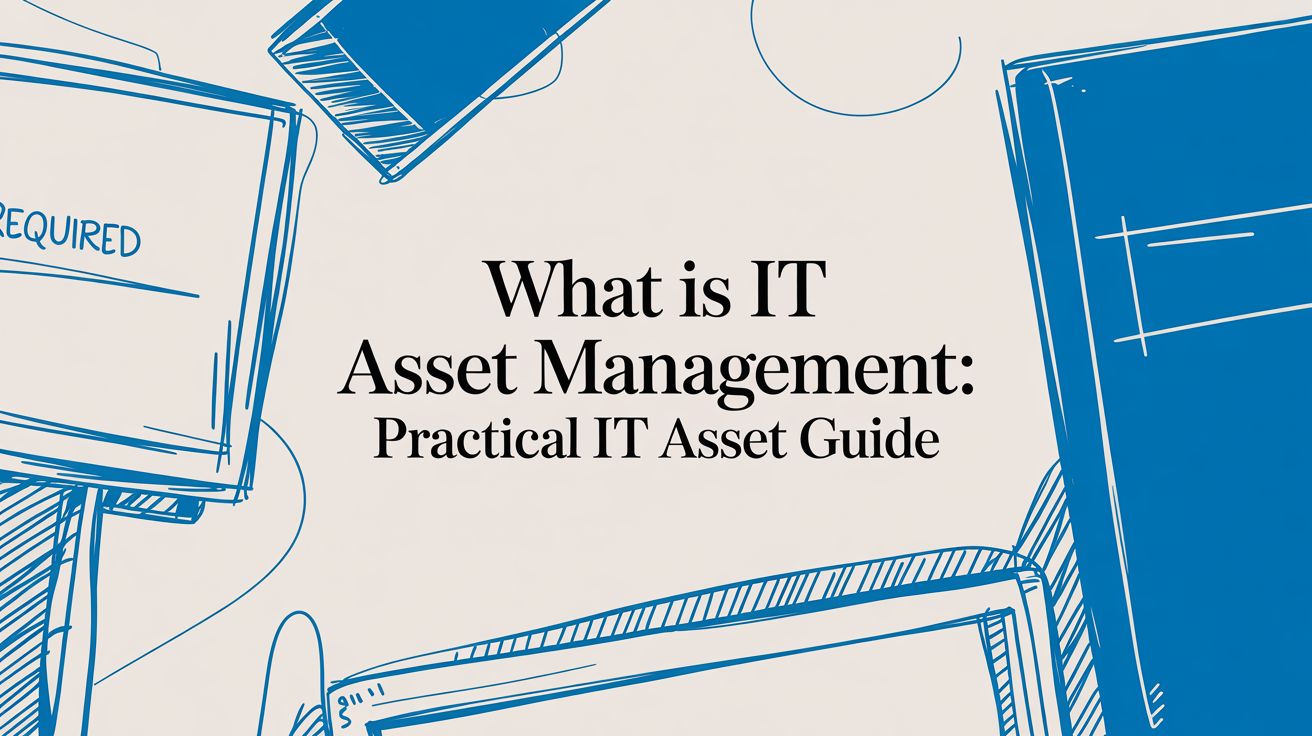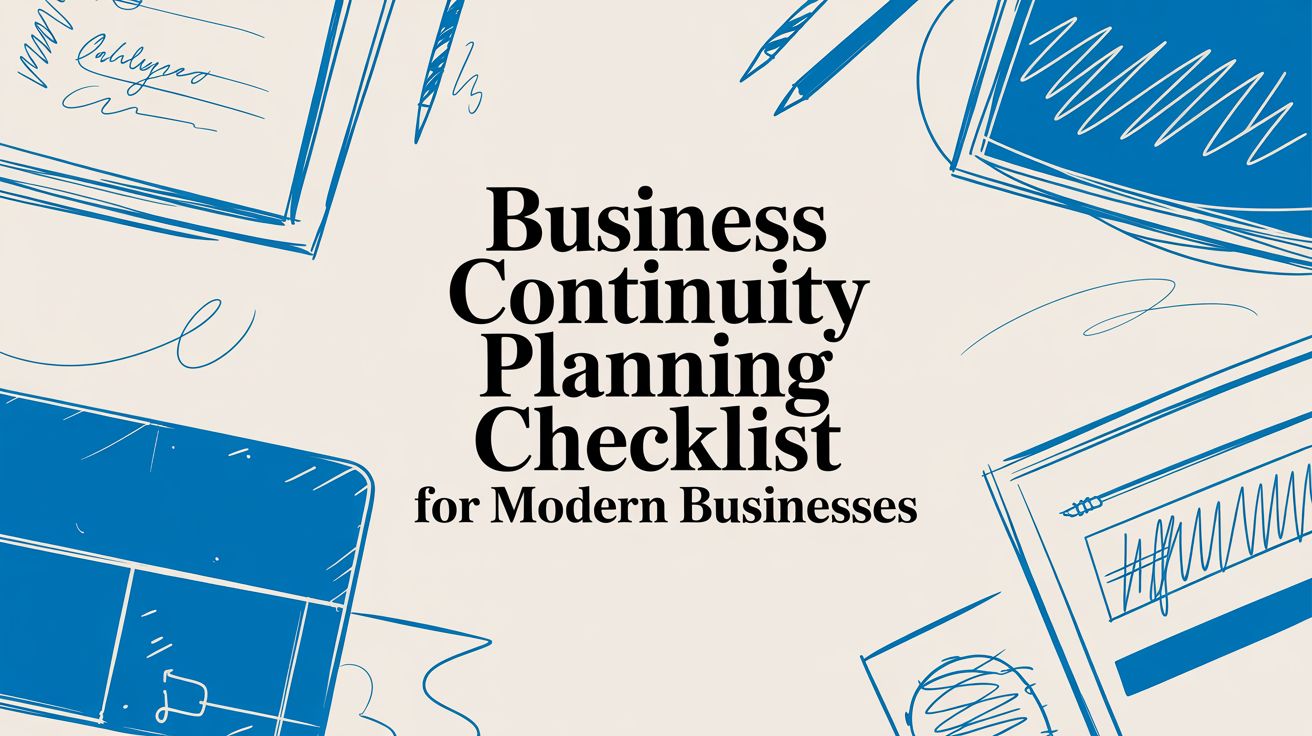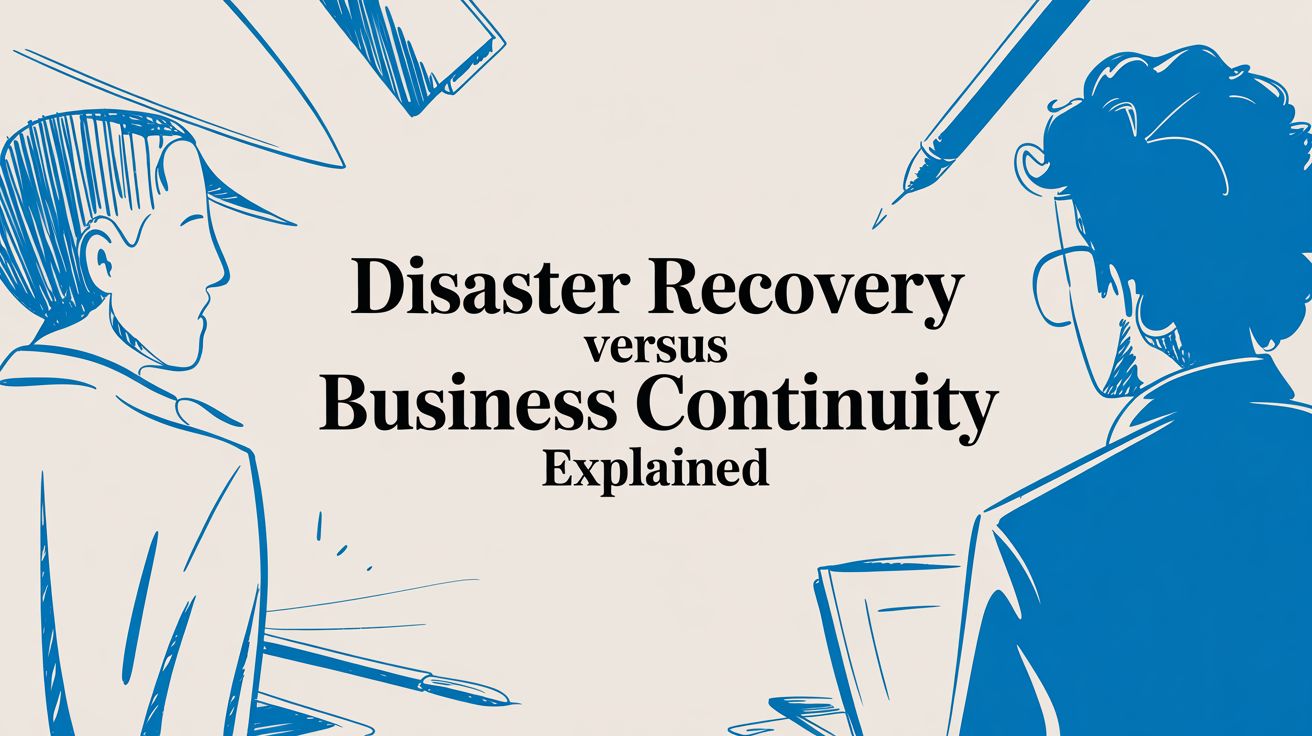How to Prevent Healthcare Data Breaches: A Practical Guide for SMBs
To protect your practice from a data breach, you need a proactive strategy that covers all your bases: the right technology, consistent team training, and a rock-solid plan for when things go wrong. Simply relying on the security features of your EHR or a basic antivirus program no longer works. Cybercriminals are far too sophisticated, and the responsibility for protecting patient data ultimately falls on your practice.
Why Healthcare Is a Prime Target for Cyberattacks
Your healthcare practice is a goldmine for cybercriminals. Protected Health Information (PHI) is one of the most valuable commodities on the dark web. It’s a complete identity kit—names, birthdates, Social Security numbers, and detailed medical histories. Unlike a credit card that can be cancelled in minutes, this information is permanent, making it incredibly lucrative for attackers.
This high-value data makes small and mid-sized practices in Dallas and Memphis especially tempting targets. Many clinics are juggling limited IT budgets, outdated systems, and staff who are already stretched thin. That combination creates the perfect storm of vulnerabilities that attackers are experts at finding and exploiting. The consequences are always severe and go far beyond an initial technical headache.
The Real-World Impact of a Breach
A data breach isn't just an IT issue; it's a business-ending catastrophe waiting to happen. The fallout can cripple your practice.
- Devastating Financial Penalties: Fines for HIPAA violations can easily run into the millions, depending on the level of negligence found.
- Reputational Damage: Trust is everything in healthcare. A breach shatters patient confidence overnight, sending them to competitors and ruining the reputation you’ve spent years building.
- Operational Disruption: Imagine your systems being completely locked down by ransomware. No appointments, no access to patient records, no billing. Your entire operation grinds to a halt for days or even weeks.
The scale of this problem is staggering. Between 2009 and 2024, data from nearly 847 million individual health records was exposed in the U.S. alone. That's more than double the entire population of the country, with an average of almost two major breaches reported every single day in recent years.
The clear takeaway here is that you can't afford to wait for an attack. For practices that don't have a dedicated in-house security team, the smartest move is to partner with a provider that specializes in managed IT services for healthcare. It's the most effective way to secure your data, maintain compliance, and keep your focus on patient care.
Building Your Multi-Layered Cybersecurity Defense
Relying on a single security tool, like a basic antivirus, is like locking your front door but leaving all the windows wide open. To effectively prevent healthcare data breaches, you need a multi-layered defense where different technologies work together. This approach, often called "defense-in-depth," creates multiple barriers that a hacker must bypass, drastically lowering their chances of success.
Think of it like securing a physical building. You have locks on the doors (firewalls), cameras inside (endpoint detection), and security guards monitoring everything (a 24/7 Managed IT team). If one layer fails, another is already in place to stop the threat. That’s the core principle of a modern, effective security posture.
This infographic lays out the dangerous path from valuable patient data to the costly fallout of a cyberattack.
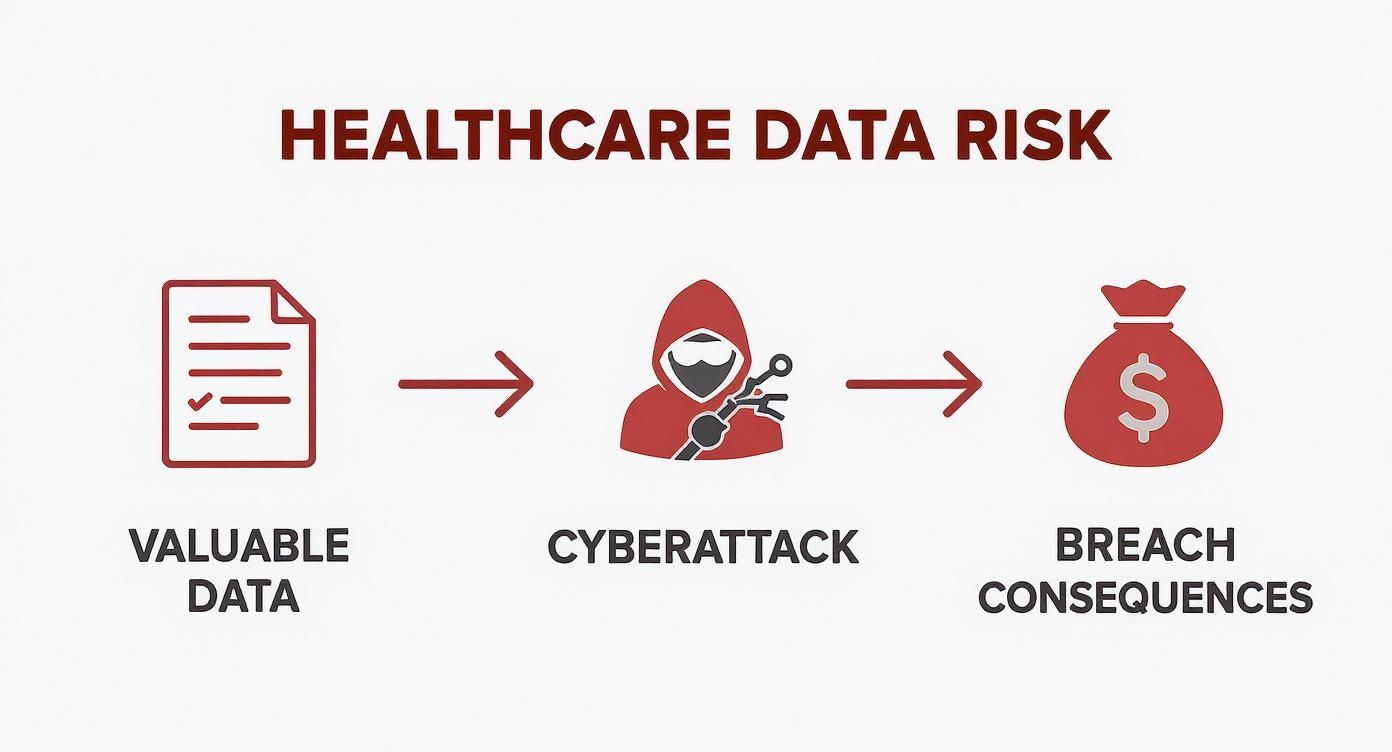
The visualization drives home the point: the high value of healthcare data makes it a prime target, which will inevitably lead to severe financial and operational damage if your defenses aren't managed proactively.
Core Technologies for Your Defense
A strong defense starts with foundational tools that protect your network and all the devices connected to it—from front-desk PCs to servers. These aren’t optional add-ons anymore; they're essential for any modern healthcare practice.
- Intelligent Firewalls: A modern firewall is much more than a simple traffic cop. It actively inspects data packets for malicious content, identifies suspicious patterns, and can even block threats based on their origin, acting as the first line of defense for your entire network.
- Endpoint Detection and Response (EDR): Traditional antivirus software scans for known threats. EDR takes a huge step further by monitoring the behavior on every device—endpoints like computers and servers. It can spot unusual activity, like a program suddenly trying to encrypt files, and automatically isolate that device to stop an attack from spreading.
- Data Encryption: Encrypting your data is non-negotiable for HIPAA compliance. This process scrambles your information, making it unreadable without the right key. It’s critical to apply encryption to data at rest (stored on servers or hard drives) and data in transit (sent over email or across the internet).
The financial stakes for healthcare organizations are staggering. For 14 consecutive years, the healthcare sector has topped all industries in data breach costs, with the average incident now costing over $7 million. A massive 78% of these breaches stemmed from hacking or IT-related incidents, and network servers were the most common point of failure.
Beyond Technology: The Proactive Element
Having the right tools is only half the battle. The other, arguably more important, half is proactive, expert-led management.
A Dallas-based clinic we work with had its traditional antivirus completely bypassed by a new ransomware variant. Fortunately, their managed security service, which included EDR, immediately detected the unusual encryption behavior. The system automatically isolated the infected workstation from the network in seconds, preventing a full-blown crisis and protecting thousands of patient records.
This real-world scenario highlights why proactive endpoint management is the difference between a minor alert and a catastrophic breach. It’s all about catching threats before they can do damage. A critical part of this is shifting to a mindset where you assume no user or device is inherently trustworthy, a concept we dive into in our guide on how to implement Zero Trust security.
Finally, a complete defense has to cover the physical disposal of old hardware. For healthcare organizations, getting formal documentation of data destruction, like a Certificate of Destruction for data security, is crucial. It’s your proof for compliance and your peace of mind that sensitive patient information has been securely and permanently wiped.
Empowering Your Team as the First Line of Defense
Your best security software is only as good as the people who use it. You can have the most sophisticated firewalls and endpoint protection on the market, but one accidental click on a malicious link can bypass it all. That's why your staff isn't a vulnerability to be managed; they're your greatest security asset waiting to be activated.
The key is turning every employee into a proactive member of your security team. This isn't just about preventing breaches—it's about building a security culture where everyone understands their personal responsibility in protecting sensitive patient data.

This shift begins with ongoing, effective security awareness training. This isn't a one-and-done annual seminar but a continuous effort to keep security top of mind.
Beyond the Annual Training Session
If your idea of training is a once-a-year slideshow that everyone clicks through to get it over with, you're missing the point. To create real, lasting change, training needs to be engaging, practical, and continuous.
Here’s what actually works:
- Run Simulated Phishing Drills: The best way to learn how to spot a phish is to get phished in a safe environment. Regularly sending out simulated phishing emails gives your staff hands-on practice. When someone clicks, they get immediate, gentle feedback on what to look for next time, turning a mistake into a powerful learning moment.
- Hold Interactive Workshops: Instead of long lectures, try short, focused workshops on specific topics. You could cover how to create and manage strong passwords one month, then focus on spotting suspicious email attachments the next. Keep it interactive and encourage questions.
- Provide Clear, Simple Policies: Don't just tell your team to "be secure." Give them the tools they need. Providing a comprehensive HIPAA compliance checklist gives everyone clear, actionable steps they can follow to protect patient information every single day.
A healthcare provider we work with in Memphis was struggling with employees clicking on phishing links. After we rolled out a continuous training program with regular phishing simulations, they cut their click-through rate by 80% in just six months. It was a game-changer and proved that investing in your people yields real, measurable security improvements.
The human element is still one of the biggest challenges in healthcare security. Even with better awareness, compromised user accounts are a constant threat. Most organizations have training, yet simple policy violations by employees remain a top cause of data loss. It's a clear sign that technology alone can't close this gap.
Building this "human firewall" is one of the most cost-effective investments you can make in your practice's security. For practices in Dallas and Memphis looking to get started, working with a managed IT partner for professional security awareness training can provide the structure and expertise needed to turn your team into a formidable line of defense.
Ensuring Business Continuity with a Solid Recovery Plan
Preventing a healthcare data breach is always the goal, but no defense is perfect. When an attack gets through, your ability to recover quickly is what separates a manageable incident from a practice-ending disaster. This is where a rock-solid business continuity and disaster recovery (BCDR) plan becomes your lifeline, ensuring you can keep caring for patients even when things go wrong.
Having a plan goes far beyond just keeping a copy of your data somewhere. True business continuity means you have a clear, tested strategy to get your entire operation—from patient records in your EHR to billing systems—back up and running with minimal disruption.
More Than Just a Backup
Too many practices think their nightly backup is a sufficient recovery plan. It's not. A simple backup is just one piece of a much larger, more resilient puzzle. A modern recovery strategy needs multiple layers to guarantee your data is safe and recoverable, no matter what happens.
A great place to start is the classic 3-2-1 backup rule:
- Keep three distinct copies of your data.
- Store them on two different types of media (like a local server and the cloud).
- Make sure one of those copies is stored securely off-site.
This simple framework protects you from a single point of failure. If ransomware locks up your main server and your on-site backup appliance, that off-site cloud copy remains untouched and ready to save the day.
The Power of a Tested Plan
A recovery plan that just sits in a binder is useless. The single most critical—and most often skipped—step is to regularly test your plan. You have to run drills. You have to actually restore data from your backups to confirm they work and that your team knows the exact steps to take in a real crisis.
A Memphis-area practice we work with got hit by a nasty ransomware attack that slipped past their initial defenses. Because they had a managed disaster recovery solution that we tested with them every quarter, the outcome was completely different from what it could have been.
Instead of panicking and considering a massive ransom payment, they initiated their recovery plan. Our team restored their entire system from a clean, off-site backup in a matter of hours, not days or weeks. They dodged a catastrophic financial loss, kept patient care going, and protected the reputation they worked so hard to build.
That result wasn't luck; it was the direct payoff from proactive planning and business continuity testing. Having a documented and tested strategy is what turns a potential catastrophe into a managed event. Preparation is the most powerful tool you have to make sure your practice can survive and thrive, no matter what threats come its way.
How Managed IT Services Provide Proactive Protection
Juggling sophisticated technology, ongoing staff training, and a bulletproof recovery plan is a monumental task, especially for a busy healthcare practice. For most small to mid-sized clinics in places like Dallas and Memphis, creating an expert-level internal security team just isn't realistic. The cost is massive, and finding the right specialized talent is a constant battle. This is exactly the gap a Managed Services Provider (MSP) is designed to fill.
Working with an MSP fundamentally shifts your IT strategy from reactive to proactive. Instead of just fixing things when they break, an MSP's entire purpose is to stop problems before they ever start. They do this through a suite of services built to keep your practice secure, compliant, and running smoothly, day in and day out.
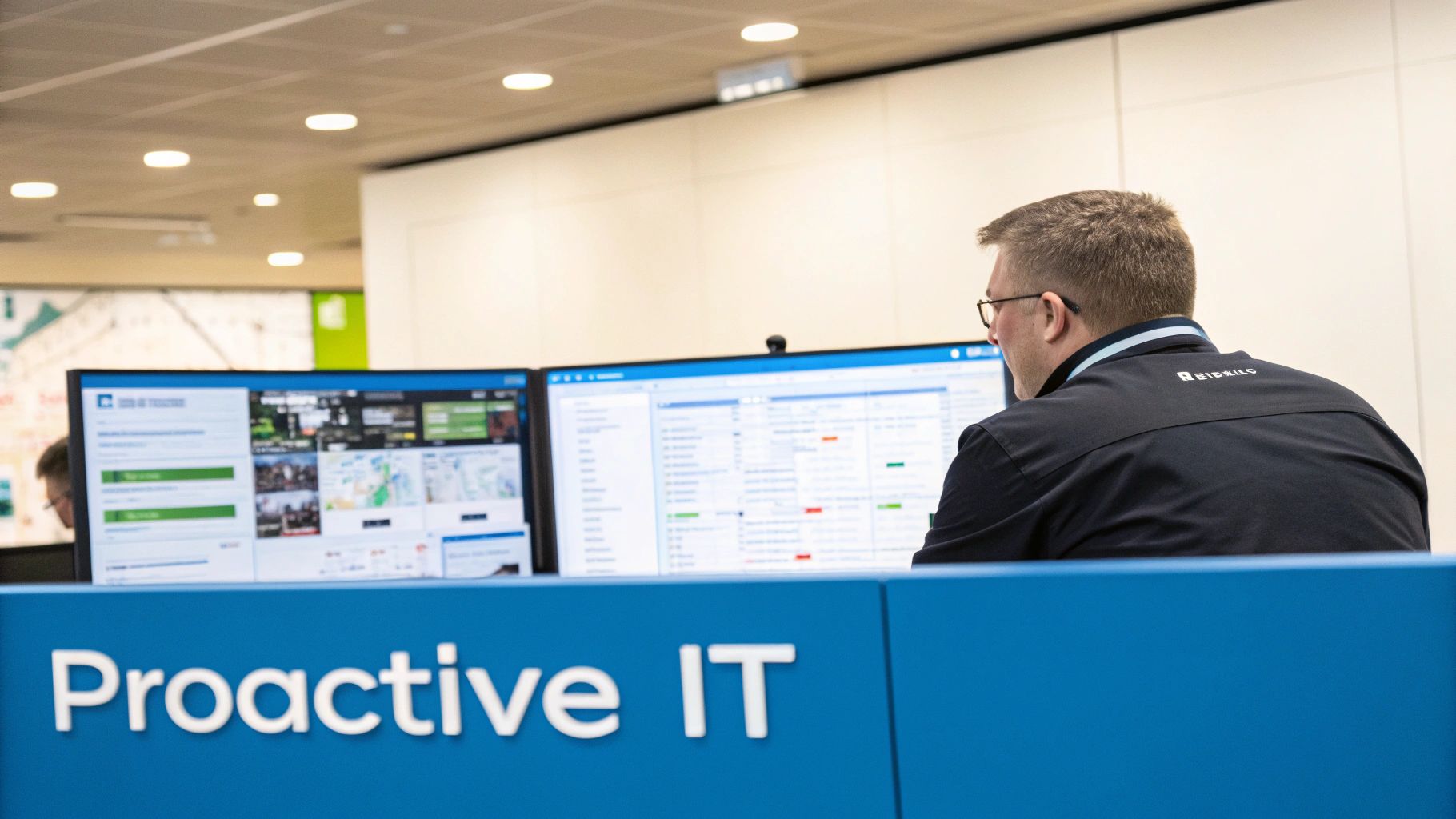
This proactive mindset is a game-changer for preventing healthcare data breaches. While your in-house staff might be bogged down with day-to-day support tickets, your MSP partner is actively hunting for threats on your network, deploying critical security patches, and managing your defenses against the newest cyberattacks.
The Tangible Benefits of a Managed Partnership
Partnering with an MSP isn't just about outsourcing IT; it's about gaining access to enterprise-grade security tools and expertise without the enterprise-level budget. The advantages are real and directly impact your security and your bottom line.
Here’s what that looks like in practice:
- 24/7 Monitoring and Threat Detection: Cybercriminals don't work a 9-to-5 schedule. An MSP provides round-the-clock monitoring, using advanced tools to spot suspicious activity and shut it down before it can turn into a crisis.
- Automated Patch Management: Unpatched software is one of the easiest ways for hackers to get in. An MSP automates this vital task, ensuring every one of your systems—from servers to front-desk computers—is always updated with the latest security fixes.
- HIPAA Compliance Expertise: Let's face it, HIPAA is complicated. A healthcare-focused MSP lives and breathes these regulations. They help you implement the required technical safeguards, perform risk assessments, and keep your compliance documentation in order.
An MSP offers a powerful strategic advantage. It’s the peace of mind that comes from knowing a dedicated team of experts is constantly protecting your practice, freeing you to focus on what you do best: caring for your patients.
In-House IT vs Managed IT Services for Healthcare
For a small practice, the contrast between handling IT in-house and partnering with an MSP is striking. One approach leans on limited internal resources, while the other gives you a deep bench of specialists. If you're still wondering what managed service providers do in more detail, our guide breaks it down.
The table below gives you a clear side-by-side look.
Ultimately, choosing managed IT services comes down to leveraging expertise and economies of scale. For small and mid-sized healthcare practices, it's the most effective way to build a robust defense, keeping both your patient data and your reputation secure.
Common Questions on Healthcare Data Security
When it comes to healthcare data security, practice managers and business owners are often juggling a lot of questions. Getting straight, practical answers is key to protecting your patients and your practice. Let's tackle some of the most common questions we hear from clinics in Dallas and Memphis.
How Can a Small Practice Possibly Afford Enterprise-Level Cybersecurity?
This is, without a doubt, the question we hear most often. The answer isn't about buying expensive gear; it's about partnership. Small practices get access to top-tier security by working with a Managed IT Services Provider (MSP).
Think about it: instead of a massive upfront investment in hardware, security software, and the six-figure salaries of specialized staff, you pay a predictable monthly fee.
This model completely changes the game. It gives your practice instant access to a shared team of cybersecurity pros and sophisticated tools—like a 24/7 Security Operations Center (SOC)—that would otherwise be financially impossible. You're essentially converting a huge capital expense into a manageable operational one.
What's the Single Most Important First Step We Can Take to Improve Data Security?
If you do only one thing, start with a comprehensive security risk assessment. Honestly, you can't protect what you don't fully understand. This assessment is more than just a check-the-box exercise; it's a fundamental requirement under HIPAA for a reason.
It’s a deep dive into your practice's digital DNA, and it accomplishes three critical things:
- It maps out your data: You'll know exactly where every piece of electronic Protected Health Information (ePHI) is created, stored, and sent.
- It checks your current defenses: The assessment evaluates your existing security measures to see what’s working and, more importantly, what isn't.
- It finds the weak spots: It uncovers the specific vulnerabilities an attacker would look for first.
A good MSP will perform this assessment and hand you a clear, prioritized roadmap so you know exactly what to fix and in what order.
Isn't Our EHR Vendor Responsible for Protecting Our Patient Data?
This is a huge and often costly misunderstanding. While your Electronic Health Record (EHR) vendor is responsible for the security of their platform, your practice is ultimately responsible for how that data is accessed and used. It's a classic shared responsibility model.
Your vendor secures their cloud, but you are accountable for everything else. That includes your local network, who has access to what, protecting your computers from malware, and training your staff not to click on phishing links. Relying solely on your vendor leaves gaping security holes that hackers are all too happy to walk through.
Ready to turn these answers into action? The expert team at PWR Technologies LLC specializes in providing proactive, HIPAA-compliant IT support that protects your practice and keeps you focused on patient care. Secure your free consultation today.


